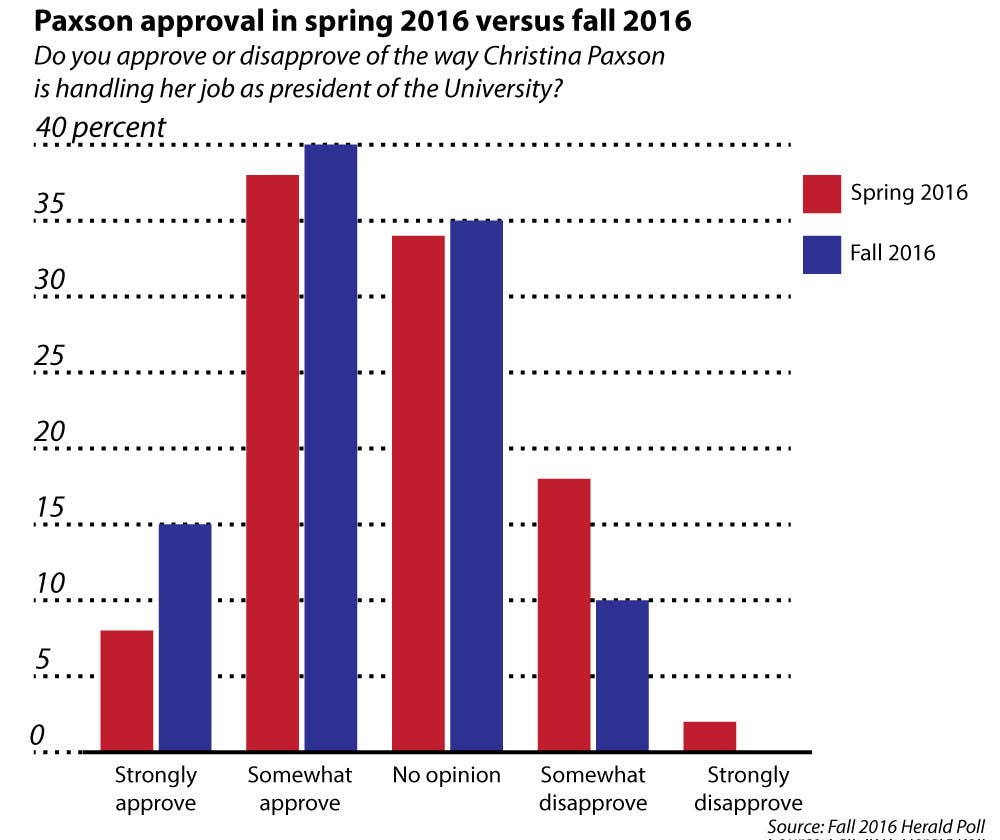With four years under her belt, President Christina Paxson P’19 has faced a great deal in her short time at Brown. From student protests regarding the Diversity Inclusion Action Plan to the cancellation of Janet Mock’s lecture last semester, Paxson must regularly navigate incidents on campus that have the potential to sway student opinion of her administration. Despite all these challenges, data from The Herald’s fall 2016 undergraduate poll show that Paxson’s approval ratings have increased steadily since last semester.
The poll, which asked students whether they approve or disapprove of the way Paxson is handling her job as president of the University, found that 14.9 percent and 39.7 percent of respondents strongly approved and somewhat approved of Paxson’s performance, respectively. This marks an improvement from last semester’s poll, which found similar approval leveled at 8.3 percent and 37.8 percent, respectively.
While the number of students without an opinion stayed relatively steady at 35.2 percent, Paxson’s disapproval ratings fell markedly since last semester. Only 9.6 percent of students somewhat disapprove of Paxson’s performance, down from last semester’s 17.4 percent. Additionally, the number of students who strongly disapprove of Paxson has fallen from 2.2 percent to 0.6 percent.
“She’s like a mirage,” said Dennese Salazar ’19, remarking on a perceived lack of visibility on Paxson’s part. “She doesn’t seem to be that big a part of the community,” she added, noting that in her two years at Brown, she has only seen Paxson speak publicly at one event.
“A particular point of emphasis for the president is to convene intimate gatherings that bring together small groups of students and offer the opportunity for face-to-face discussion around specific issues,” wrote Director of News and Editorial Development Brian Clark in an email to The Herald.
Erin Schaeffer ’17 expressed similar sentiments about a sense of distance from Paxson. “I really don’t interact with her, … and I don’t see her around that much,” she said.
Brown’s previous president, Ruth Simmons, achieved record approval ratings during her tenure, with 38.4 percent of students indicating strong approval in The Herald’s fall 2011 poll. Simmons’ popularity could be an explanation for Paxson’s relatively less-enthusiastic ratings, Schaeffer said, adding, “I know the previous president was really well liked. I’m sure the university was sad to see her go.”
Paxson’s approval varied slightly by gender, with somewhat more men supporting the president than women. Men were 2 percentage points more likely to strongly or somewhat approve of Paxson’s performance, while women were almost twice as likely than men to somewhat disapprove of her performance. The margin of error for men who took the poll is 4.05 percent, while the margin of error for women who took the poll is 3.74 percent.
Race played more of a role in determining approval of Paxson, with white students composing her largest base of support. About 16 percent and 42.9 percent of white students indicated that they strongly or somewhat approved of Paxson, respectively, while those percentages fall to 12.4 and 35.7 percent for black students.
“Paxson is doing really well in terms of sexual assault cases and diversity issues,” said Amber Teng ’17. “Beyond that, I don’t have a strong opinion about her.” Despite having witnessed Paxson’s initial years at Brown, Teng said that she still feels relatively indifferent toward the president’s administration.
“She’s kind of always trying to do better,” said Calvin Nickelson ’18. “I’m sure there’s more she could be doing, but she’s not like other university presidents that don’t listen at all.”
Nickelson said that Paxson’s handling of the Diversity and Inclusion Action Plan last semester showed that administrators are willing to be receptive to student concerns on campus. “Even if she’s not willing to shake everything up, she seems willing and eager to make changes that make people’s lives better,” he said.
“Student engagement plays a key role in informing the president’s perspective as she works across the University,” Clark wrote.





